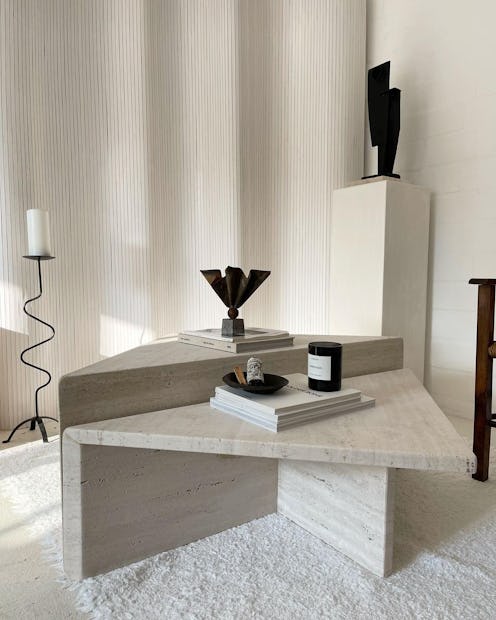(Trends)
The '90s Are Back, And They're Coming For Your Home
Throwback, anyone?

Tacky florals. Lifeless tan wood finishing. Weird geometric shapes and detailing. Yes, these are likely the things that come to mind when you think of ‘90s home design, right? But, with a closer look, you’ll find that this decade actually produced some stunning and timeless trends. In fact, the prevalence and desire to use natural and organic materials as opposed to the synthetic alternatives that took hold in later years was pronounced, and it’s this sentiment that’s seeing a major resurgence today.
Dean Levin, founder of Los Angeles based architecture and design firm, 22RE, notes that he’s seen a specific increase in popularity with lime plaster, travertine, and plywood panelling. When asked why he thinks these styles are trending, Levin says, “The general nostalgia for ‘90s culture that we’ve seen in fashion and music, that transfers to spaces as well. Through the internet people are discovering designers from that time, so we’re using these references again.”
Levin often goes to lime plaster, travertine, or plywood when he’s looking for ways to add warmth and dimension to a space. Lime plaster (a type of high end plaster with lime mixed in), for example, produces amazing variations in texture and shade when applied to a wall. And while these trends remain rooted in their ‘90s counterparts, elements of each have been updated slightly to better fit contemporary aesthetics. In the case of travertine (a light, almost, beige-colored stone) Levin says people are gravitating more towards an unfilled look as opposed to the smooth Jerusalem Gold variety we saw so much of 20+ years ago. Unfilled travertine, “has cavities in it and looks more natural, which is relevant to today’s world in that people are trying to bring more natural and organic materials into their homes,” he says.
Even though it may seem like you need a full reno to get in on these trends, fear not, there are plenty of ways to get the looks while keeping your walls intact. Keep scrolling for the full rundown on the three ‘90s home design trends we can’t stop screenshotting, now.
Unfilled Travertine
Unfilled travertine is the stone in its original state, meaning that any holes or cracks within a slab are left open instead of being filled with a synthetic substance, giving it a more earthy, untouched feel. The benefit of using a stone like unfilled travertine in your home is that, “Being a very light-colored, natural stone, it’s a good way to add a high-end material, but it’s not as expensive as, say, marble or onyx” reveals Levin. Its neutral color-way works well with a variety of home styles as well, from more minimal, modern takes to traditional. Levin especially likes to use it as a countertop or flooring.
Get the Look
Plywood Panelling
Seen often in Scandinavian and Japanese design, plywood panelling is a great option to “use in place of drywall to make a room feel warmer or more rustic,” Levin explains. “It’s about making a space feel more handmade, to give it a cabin feel.” In the ‘90s, plywood panelling became popular when architects looking to modernize California’s Venice Beach were trying to come up with an inexpensive way to panel walls by not using solid lumber. “Plywood was more cost effective,” Levin says. While some are choosing to panel the entire interior of their house with plywood, others are using it more as an accent material, choosing one room, like a kitchen, to feature it.
Get the Look
Lime Plaster
Lime plaster gained major traction in the ‘90s as a way to replicate the rustic extravagance of Italian design (hello again, Tuscan kitchens). However, “there are new techniques today that allow for a more minimal, matte and neutral effect compared to then,” says Levin. He continues, “Right now we are working on two Spanish revival homes. We’re adding big flowing arches and curved staircases with formed drywall work. We love lime plaster for this because it looks like the house was almost casted, not built piece by piece.” Levin adds that its wow-factor is taken up a notch when used on long, curved, continuous surfaces. Plus, there’s a waterproof variation called tadelakt as well which makes lime plaster a formidable alternative to tiling a bathroom. Since it’s quite expensive (and should only be applied by someone with knowledge on the material), lime wash paints and roman clay work well as economical alternatives.
Get the Look
This article was originally published on